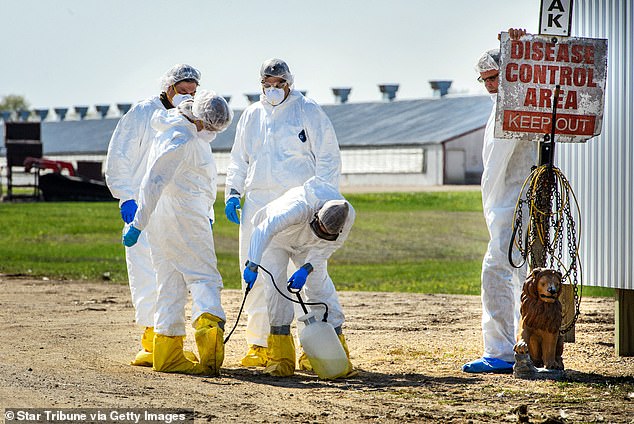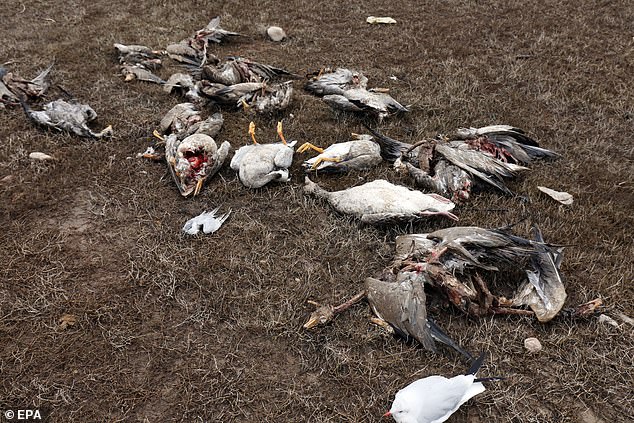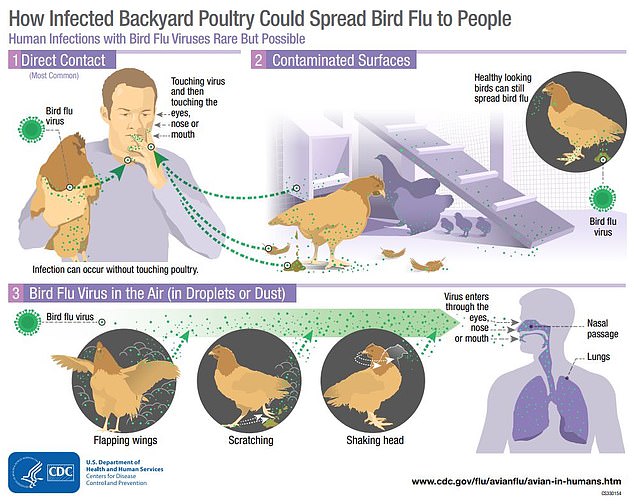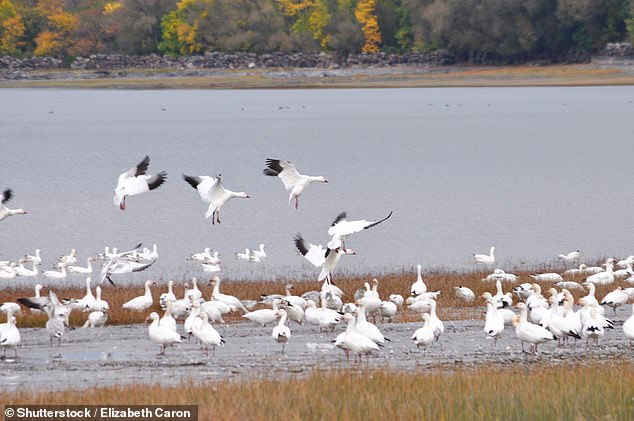Hundreds of dead birds have reportedly been falling from the sky in dystopian scenes in Pennsylvania.
The culprit is believed to be the H5N1 strain of bird flu that has devastated poultry and dairy farms across the United States and sporadically infected people.
A wildlife nonprofit in the Poconos confirmed that dozens of snow geese had tested positive for the virus.
Janine Tancredi, co-executive director of The Wilderz at Pocono Wildlife, told local news: ‘People reported like birds falling from the sky.
“It seems crazy, but because they become so neurologically disabled, they don’t know their whereabouts. They’re flying into trees. They’re flying into houses.
He said that in recent days, all 35 snow geese his team tested for H5N1 have tested positive, but he suspects the actual number of affected birds is “probably more like thousands.”
Locals are urged to avoid dead birds or contact with live birds, and to keep pets away from waterways and carcasses.
There have been no human cases of H5N1 in Pennsylvania, but residents in 10 states have been infected.
Hundreds of snow geese have died in Pennsylvania due to bird flu. Wildlife officials say they’ve ‘never seen it this bad’
H5N1 has been devastating poultry and livestock flocks since 2022 and has reached farms in all 50 states.
It was not until April 2024 that the virus infected a person who had been in direct contact with a sick cow.
Sixty-five additional human cases linked to the current outbreak have since been reported, including a severe infection requiring hospitalization in Louisiana.
The majority of exposures (40 cases) were related to dairy herds, primarily in California with 36 cases, followed by Michigan and Texas, each of which reported one or two cases.
Poultry farms and slaughter operations accounted for 23 exposures, with the highest concentrations in Washington (11 cases) and Colorado (9 cases).
Only one case involved exposure to other animals, reported in Louisiana, and two cases had unknown sources of exposure in California and Missouri.
The serious case in Louisiana has so far been an outlier. Most infections have been mild and have caused conjunctivitis, mild fever, sore throat and fatigue. But Louisiana officials said this more severe case of the disease was “not unexpected.”
The CDC maintains that the overall risk to the public is low, since the people who became ill had contact with infected farm animals.

USDA workers are shown disinfecting a turkey farm in Minnesota. Bird flu has devastated poultry herds in all 50 states since the outbreak began in 2022.

In Pennsylvania, wildlife officials believe the number of geese killed by bird flu could be in the thousands
But states are increasingly concerned.
California, where 37 human infections have been reported, has declared a state of emergency over fears it could be transmitted to people.
This is not so far-fetched, as emerging evidence suggests that the virus could mutate in such a way that it can more easily infect humans.
After the CDC sequenced the virus in the critically ill Louisiana patient who had contact with poultry and compared it to samples of other H5N1 viruses from dairy cows, wild birds, poultry, and previous human patients.
The mutations found in the Louisiana patient’s virus were not seen in poultry living on the patient’s property, suggesting that the virus did not already have these mutations when the patient was infected.
Instead, these changes likely developed as the virus multiplied inside the patient’s body.
But the most positive thing is that the changes did not fundamentally alter the overall “avian” characteristics of the virus. The virus still mainly retained the genetic traits suitable for infecting birds, not humans.
Diseases among livestock take a huge toll on farmers’ incomes.
And as farmers cull their flocks of poultry and dairy cows, the food their farms produce decreases, leading to limited supply, which translates into higher prices for consumers.
However, bird flu affects more than just farm birds, as shown in Pennsylvania, where the state Game Commission said it is suspected of causing the deaths of about 200 snow geese in the greater Pennsylvania area. Allentown.

Like all flus, the virus is spread primarily through airborne droplets that are breathed in or enter a person’s mouth, eyes, or nose.
About 50 miles north, the Pocono Wildlife and Rehabilitation Center has taken in dozens of birds showing symptoms of bird flu since mid-December.
Sampson Metzgar, a bird specialist at the center, saying: ‘Tremors, a lot of head movements, a lot of lack of coordination. They are struggling to keep their balance, walking a few meters and then sitting for a while. The birds almost seem disoriented and confused.’
Meanwhile, Ms. Tancredi of the Wilderz at Pocono Wildlife said her team is “euthanizing on arrival.”
“We really have no choice.”
When she and her team arrived at a quarry in the Nazareth area on Thursday, they discovered hundreds of birds that had already died, she said.
He added that the total number of birds affected is “probably more like thousands.”


